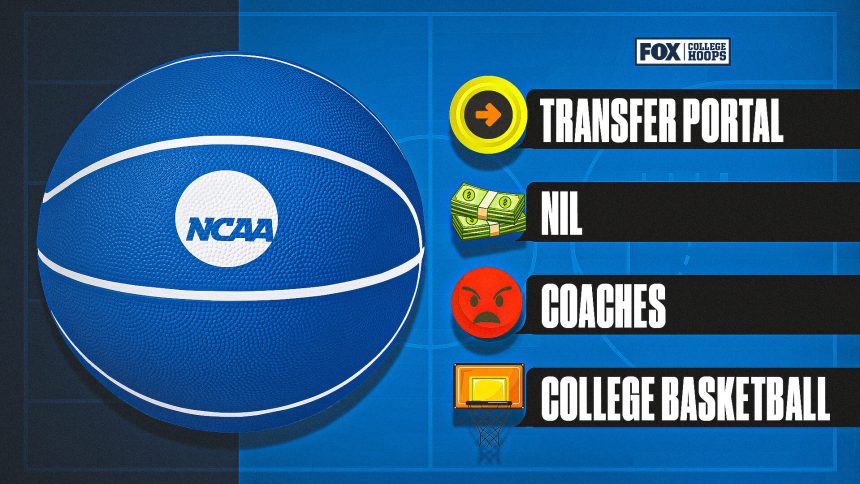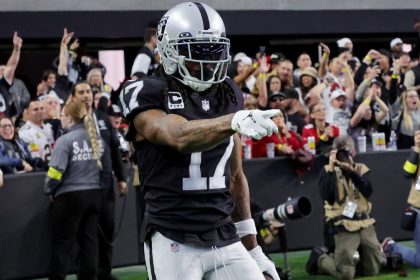On Tuesday night, Kim English boiled over with frustration. The 35-year-old Providence men’s basketball coach took to social media to voice frustrations that many coaches possess, but that few publicly talk about.
After rumors swirled that Providence senior Bryce Hopkins, a first-team All-Big East selection, could be entering the transfer portal, English elected to clear the air with a post on X.
“To all the tampering head coaches and assistant coaches and flunkies … just call me and let me know if you want to recruit our players. Leave them and their families alone,” wrote English, who is coming off a 21-14 season in which Providence narrowly missed the NCAA Tournament — in part because Hopkins tore his ACL in early January.
With the transfer portal entry deadline arriving at 11:59 p.m. ET on Wednesday, Hopkins was rumored to potentially be on the move. Several coaches across the country were reaching out to the Friars’ standout forward, with some willing to pay him up to seven figures to play for their program, sources told FOX Sports.
ADVERTISEMENT
To be clear, Hopkins is hardly the only player in this scenario. Hundreds, if not more, have been contacted by opposing programs before entering the portal. Tampering? It happens every day in college basketball‘s wide-open market. In fact, multiple sources who handle the generation of NIL dollars at high-major schools told FOX Sports that they’ve set budgets of $4 million for next year to construct a team. Some schools have surpassed that mark this offseason, and high-majors that are hovering only around $2 million — yes, only $2 million — will require a coach to be extra meticulous. By the same token, at some schools, certain donors are turned off by the idea that the players have all of the control.
But the bottom line is that the money has led more than 1,800 men’s college basketball players to enter the transfer portal this year. It’s smart to enter and capitalize on your value.
In today’s college basketball landscape, there is no longer anything keeping a player from leaving a program for the opportunity to make more money. Players can transfer as many times as they’d like without the penalty of having to sit out a year. So, with the lack of guardrails in place, can you really blame an athlete for switching schools if a better financial opportunity presents itself? It would be irresponsible not to take the best offer.
On the other hand, this new climate has created a sense of never-ending chaos. College basketball is now pay-for-play, but this is not the same as professional sports. Pro athletes work in a league and agree to terms through a player’s association, in a system that includes guardrails and a contract system. College basketball has no structure or system. It’s utter madness, and when it comes to the sport’s health, it’s not sustainable.
Here is how a variety of college coaches, who spoke with FOX Sports under the condition of anonymity, described the current state of the game:
One blue-blood head coach:
“For us coaches, this is not what we signed up for. I signed up for this to preach the education and an opportunity, and to see the players grow and mature, to fight through adversity and work through mistakes. Shame on the NCAA for not seeing this coming years ago, from Myles Brand to Mark Emmert to Charlie Baker.
“I’m not mad at student-athletes at all. They’ve set their own value. We, the coaches, have lost any leverage. I am not mad at these kids for earning money. I think they should. Not having a boundary or system in place, to be able to regulate equity or fairness is a f—ing disaster. To not have regulation is crazy. These collectives are going to get coaches fired. We have had no break. Not one coach in the country has had time to sit back and breathe or spend time with their families.
“There should be a 30-day portal window, and it should open the week after the tournament starts. We’re constantly checking the portal and waiting for it to close while having two, three or four guys in a workout. It’s a shame. It’s embarrassing and I don’t like it. I had a kid enter the portal this past week because he saw that we added another player who plays his position. But that’s not to say the new kid was taking our other kid’s job. And yet, he wants to enter the portal. You’re going to get attrition once you start getting commitments. No kid wants to fight through adversity.
“Poll the veteran coaches. You should have a poll out there. How many coaches are going to withstand it? How many veteran coaches are going to stick around for this? There will just be another circus next year, and I guess we’re the f—ing clowns running around. We need a system immediately.”
One Big Ten head coach:
“It’s an absolute mess. The NCAA Tournament is still the best sporting event going, but interest in the regular season has really declined due to a number of factions led by the transfer rate in our game. The inflation in NIL has gotten out of control.”
One Big East head coach:
“We are in a system of corruption. The third party controls college basketball. Young people are made to believe they are entitled to money. On the surface, that is fine. However, there are no guardrails, expectations or accountability attached. It’s a dangerous precedent to set for their respective future and the future of college basketball.”
One A-10 head coach:
“The current climate of college basketball is disgraceful. It’s currently creating an ultimate disease for us (coaches). The climate is going to hurt our student-athletes beyond measure, but the results will be glaring in 5-6 years when the current graduates have absolutely no alumni base they feel connected to. Ninety percent of our athletes’ careers in sports will be over in 5-7 years and they will be stuck with no support to help them with life after basketball other than those of us who are truly in it to help develop them into great men. Having said that, it’s the nature of the beast and everyone must try and do their best to develop as strong of relationships as we possibly can and understand that we may get treated unfairly, but we have to stay true to our standards and still create environments that nurture growth!”
One mid-major head coach:
“We do need guardrails and a salary cap and I have a major concern about what graduation rates will soon look like and those have been pretty strong the last 20 years. The rate at which people are transferring and the money they’re being paid, while it’s great for the kid, is concerning for someone in our seats. The low-major and mid-majors in this are feeder programs. It’s really hard to rally university communities around teams with 10 fresh faces every single year. We’re no longer running a program. We’re just trying to assemble a team year in and year out. That’s not what this is supposed to be about.”
It has become pretty clear that coaches are fed up with the current state of affairs, but the complaints have been occurring for quite some time and have only increased.
It’s time for these complaints to turn into changes. It’s time for the court dates to turn into acknowledging the reality of the situation and adapting for the sake of everybody involved.
There’s no stopping this environment, but rather, NCAA leaders and the rest of the powers that be must accept the fact that the amateur model is gone. There is no value in trying to preserve a model that’s no longer applicable when payment and unlimited transferring is allowed. Why? Because right now, this is free agency, but with a complete lack of structure, there will never be sustainability.
Mit Winter, a leading lawyer specializing in name, image and likeness for college athletes, and who is a former player at William & Mary College, joined FOX Sports for an exclusive interview this past week.
Winter spoke about the current federal case happening in the Northern District of California, House vs. NCAA, which argues that the association is breaking federal law by placing any restrictions on how athletes make money from selling the rights to their name, image or likeness. This multi-billion-dollar lawsuit, being overseen by Judge Claudia Wilken, who has ruled against the NCAA previously in both Alston and O’Bannon, could be trending toward a settlement that drops a fee of more than $4 billion in back payments to past college athletes. The greater point is what could come from this settlement: revenue sharing in college sports, and salary caps across schools, which would now be directly paying their athletes.
“This cap would be based on average revenue of Power 5 schools, and based on what we know, that number would be around $20 million per school per year,” Winter said. “Everyone knows that revenue sharing is going to have to happen in some form, but just allowing revenue sharing … it does not solve all of the issues facing college athletics right now. So, this settlement case is not a silver bullet that solves all of the issues.”
Winter explained that the hurdle with creating a unilateral salary cap across schools is that the NCAA wants Congress to grant an antitrust exemption, which in return gives the association the ability to enforce it, something that is not going to happen.
“You can collectively bargain the cap like the NBA or the NFL,” Winter said. “Those are allowed because they are collectively bargained with the players associations in those leagues and if you collectively bargain rules like that, they become exempt from antitrust laws. This can also create some guardrails with player movement. The reason why the NCAA has no transfer rules is because it lost an antitrust suit. If there is collective bargaining, you are exempt from antitrust law.”
So, what’s the first step on a pathway to collective bargaining? First off, to collectively bargain, the athletes would have to be employees and have a union.
“A lot of people just don’t want to go there right now in college sports,” Winter said. “Because one of the main arguments to Congress when the NCAA is asking for an exemption is that if they are using their revenue to then pay football and basketball athletes, then that is going to harm or cause them to cut non-revenue sports.”
That’s why Winter believes that down the road, football and basketball college athletes will be compensated, and only a limited number of others would be paid through a method of collective bargaining.
Winter weighed in on how collective bargaining could help with the player movement issue in college basketball.
“Adapting means you can have a way to have some limits on movement, with players potentially entering into contracts that say, ‘you’re here for two years and if you leave prematurely, there’s a buyout fee that must be paid,'” Winter said. “A lot of people don’t like coaches complaining about how hard it is to put a roster together, but I would say it’s not necessarily a great thing for the person if you’re moving schools every year because it can make it harder to graduate. There have been guys who have tried to transfer but are unable to due to the progress toward a degree and the credits not aligning. Even at the pro sport level, there are limits on how often you can move teams.”
That brings up a question on the other side of this whole conundrum: Since the players currently have all the freedom in the world, why should they collectively bargain? What’s in it for them?
“There would obviously have to be pretty big concessions from the school and conference side, ones that are financial but others that provide benefits and protection,” Winter said. “There would have to be pretty big trade-offs to get athletes to agree to limit their freedom of movement. But professionals do it all the time, so I don’t think it’s something that would not happen, but it would have to be the right deal for athletes to agree to that.”
We’ve seen some small steps taken in this process. Athletes.org co-founder Jim Cavale recently had the entire UAB football program sign up with his program this week, offering athletes pro bono experts to assist with their marketing and NIL deals. Cavale’s goal is to represent athletes in future revenue-sharing plans.
But right now, in a world where the NCAA Men’s Basketball Tournament is generating roughly $1 billion for the NCAA, good for 85% of its annual revenue, Winter states that it’s time for the association to get real with its protocols.
“College basketball is functionally a professional sport,” Winter said. “But, it has rules that pretend this is some sort of amateur, extracurricular activity. The current model is not a model you would create if you sat down and were creating something from scratch on paper. Where we are currently is not best for all parties involved.”
It goes beyond just player compensation, collective bargaining and potential contracts replacing the dead amateur model as well. There are intricacies within the sport that need to be changed as well.
For instance, the May 1 deadline for players to enter the portal was 11:59 p.m. ET, but all a college player had to do was announce his or her desire to transfer to any representative at their current school, whether that be a text message or email, that timestamp alone would suffice for entry into the portal. Now, only three men’s basketball players appeared in the portal after 10 p.m. ET on deadline night, with 45 players total entering on the final day, barring a late entry that notified their school but has yet to be placed into the portal. The principle of this matter and the midnight deadline makes one ask: What are we doing here?
Then, there’s the transfer portal opening on what coaches now term Selection Monday, with players across the country entering the portal the Monday immediately following Selection Sunday. So, yes, during a week when 68 teams are getting ready for the best postseason event in sports, coaching staff members of NCAA Tournament teams are hitting refresh on their laptops to keep the portal updated so that they don’t get lost in the race to acquire players.
You have assistant coaches making phone calls to potential players for the following season while their current players are getting ready with undivided attention for their potential “One Shining Moment.” The portal opening just six hours after an NCAA Tournament field is announced is a massive swing and a miss, one that could be avoided if, at the very least, the sport’s leaders waited one week.
Again, it’s the player’s right to enter the portal, and they should do that if they want a new destination and want to capitalize on their value. But can we not give it at least seven days?
We will see if the NCAA listens. The association is acknowledging its issues, but will it acknowledge what actually has to happen for material changes to occur? The pathway feels inevitable, so why not try to save oneself by doing what’s necessary to get closer to a middle ground.
The one-and-done rule was once said to be killing college basketball’s buzz. Then, G League Ignite was reportedly going to hurt the sport. College hoops has stood the tests and challenges from projects and theories. The irony is that right now, the sport has to look at its collective self in the mirror and do something to fix the problems.
As much as it creates headlines and news around college basketball during what has typically been a dead time, having no real structure, or worse, pretending there is one, has led to a sport that is currently in a dangerous place and needs repair.
John Fanta is a national college basketball broadcaster and writer for FOX Sports. He covers the sport in a variety of capacities, from calling games on FS1 to serving as lead host on the BIG EAST Digital Network to providing commentary on The Field of 68 Media Network. Follow him on Twitter @John_Fanta.
recommended

Get more from College Basketball Follow your favorites to get information about games, news and more












